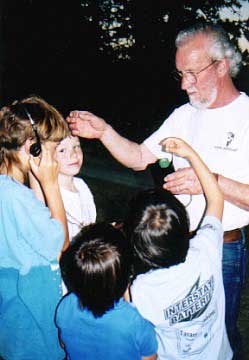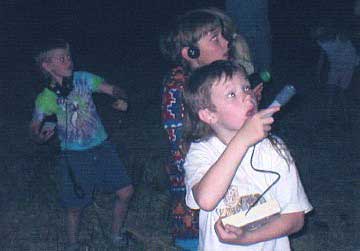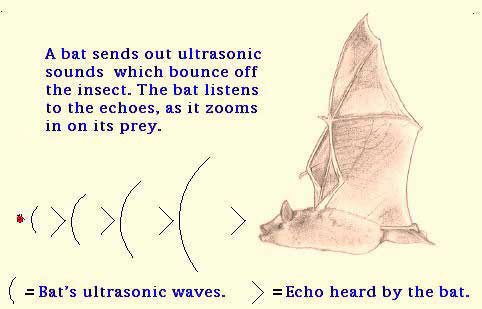

|
Listen to a real bat;  Click bat! |
 Getting the children ready for bat watching.
|
We are at Pacifica, a beautiful garden farm in the Siskiyou Mountains, with woods, open fields and large irrigation ponds - a perfect place for bats. There is an occupied bat house on a tall post where bats roost for the summer. This evening we are near an irrigation pond - seven children, several parents and the owner/co-ordinator of an educational program for children, that takes place at Pacifica. We are here to watch and listen for bats. I have five bat detectors to share with the little folk, and big folk. We talk about bats for a few minutes, and look at posters and pictures of bats. I explain how the bat detectors work and pass them around to the children. I snap my fingers in front of a sensor to show how the bat chirp might sound. In a second, all the children are snapping, clapping and shouting into the detectors. Dusk comes. There is a breeze over the pond. We wait. No bats appear. |
 Listening for bats at Pacifica, Williams |
We move to the side of a large hay field with a wire fence around the perimeter. A lot of grass grows along the fence line. Several children discover that there are sounds coming from the grass near the fence. These kids are excited. With one of the bat detectors, I confirm that, yes, there are many loud, ultrasonic, sounds coming from the grass near the fence. It is too dark to see any bugs but there certainly must be a lot in there. A beautiful, white barn owl flies along the fence line near the forest. It circlie the field, passing near where we stand. Then, it disappears as it finds its way away from the disturbing crowd. One of the fathers shouts: "Bat! bat!" We all look toward him, then up to the sky. He is wearing headphones and holding a bat detector. Sure enough, a large bat is flying overhead. It flies along the edge of the field and makes several circles above us. The children go wild. "I hear it! I hear it! There's another one. Do you hear it?" The bat flies away and in a few moments everything is quiet. It is getting late and time for little ones to be in bed. |
 Bat Echolocation |
Bats send out ultrasonic waves (chirps), sounds that we can't hear without the aid of a bat detector. When the sound hits an insect, an echo is heard by the bat. The bat can identify the insect, its size and shape, and which way it is moving from the sound of the echo. Most bats use this echolocation to navigate the dark night and hunt for their food. |
Next Page - Parts of a bat, and a bat story ....
![]()
Home Page .... Bats of Williams .... ![]()
Thanks for your visit. If you have any comments or questions, please e-mail:
lajones@wolfdenpress.net